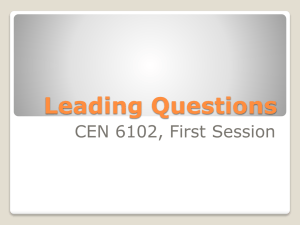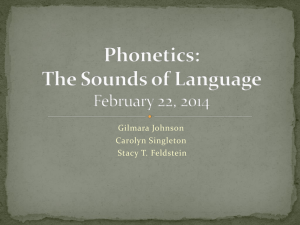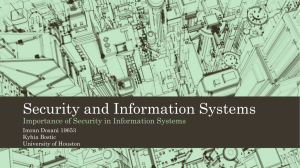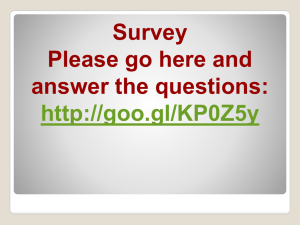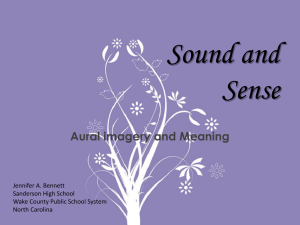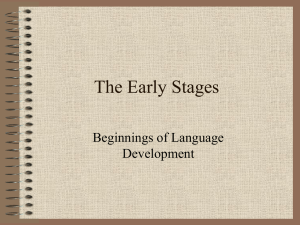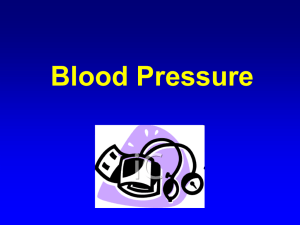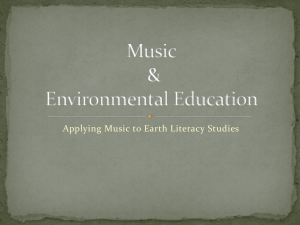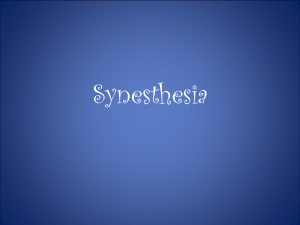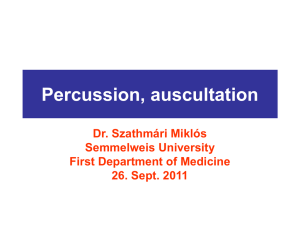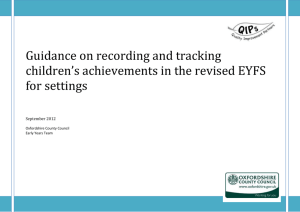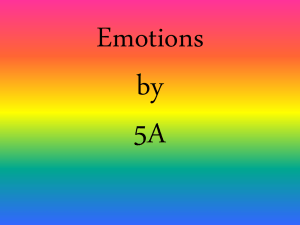Chapter 4
advertisement
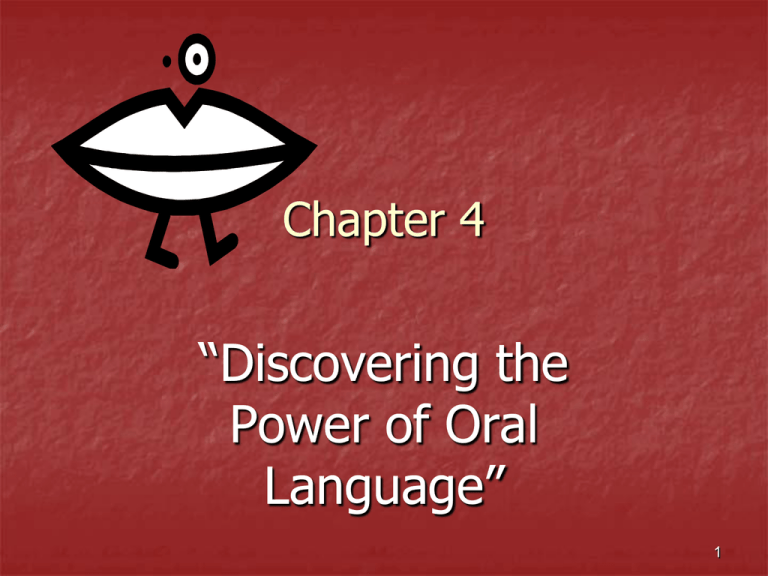
Chapter 4 “Discovering the Power of Oral Language” 1 Topics of Discussion Defining Language Characteristics of oral language Characteristics of speech sounds Putting language into perspective Understanding and using power language Understanding levels of usage Functions of oral language Language to avoid 2 Section 1 “The Nature of Oral Language” 3 Defining Language Language has rules Rules differ from written Seldom taught directly Learned from listening and using 4 Defining Language Language is like a code 5 Characteristics of Oral Language Meaning 6 Characteristics of Oral Language Vocabulary Need variety of words just like you need variety of clothes 7 Characteristics of Oral Language Structure Way parts of language are arranged Grammar Basic understanding of rules that regulate language 8 Characteristics of Oral Language Sound Dr Fox Hypothesis People are judged on speech sounds The way you sound affects message 9 Why building vocabulary is important Makes an impression of who you are and what you’re like Depends heavily on context and subject to standards of appropriateness Allows clear and effective expression in wide range of situations with wide range of people Allows interpretation of others’ messages Adds interest and personality 10 Characteristics of Speech Sounds Diction Determined by choices in pronunciation, articulation and enunciation Pronunciation Listed in dictionary Use first listing Mark of a knowledgeable and literate person 11 Characteristics of Speech Sounds Articulation Consonant sounds Omission errors – leave out sounds Addition “ - add sounds Substitution “ - use one sound for another Slurring “ - consonant sounds run together Jeet? Novyu? Surefyurgonna. Nopedyuwanna? 12 Characteristics of Speech Sounds Enunciation Vowel sounds Faulty placement of teeth or tongue can distort sounds Usually subconscious 13 Characteristics of Speech Sounds Dialect Can refer to a language that only exists is oral form Regional dialects EX: Navajo code talkers EX: southern drawl Ethnic and cultural dialects Acceptable only within region or culture 14 Speaking Clearly and Effectively Make appropriate choices with knowledge and understanding of choices Draw from large flexible vocabulary Add conventions and rules appropriately Practice clear diction Eliminate distracting elements 15 Putting Language into Perspective Personal implications Conveys attitude Determines success Effective strategies Increase knowledge base Build vocabulary – practice in safe environment Use clear statements and clear questions Use clear diction Use effective language to build positive relationships 16 Cultural Implications of Oral Language Historical research Early 1800s Jakob and Wilhelm Grimm Traveled throughout Germany Stories’ minor details changed but major points the same Became fascinated with differences in language Wrote phonetic descriptions of speech patterns and language choices 17 Cultural Implications of Oral Language Grimm’s Law No one speech pattern is superior to another Oral language in each area best serves the needs of people within that culture. No grammatical errors with in oral culture Agreed upon language is only good within the culture Crossing culture lines may make choice inappropriate 18 Section 2 “Developing Skills for Power Language” 19 Understanding and Using Power Language Characteristics of power language Clarity How Precise speech, clearly organaized and grammatical, easy to understand Effects May develop image as knowledgeable, efficient communicator. Understanding enhanced by ability to speak effectively. 20 Understanding and Using Power Language Characteristics of power language Courtesy and tact How Listens empathically, negotiates respectfully, disagrees agreeably, focuses on issues not people Effect Respect and consideration promote positive relationships, 21 Understanding and Using Power Language Characteristics of power language Ownership of thoughts and feelings How Uses “I” to express opinions, ideas, and feelings “I was bored” not “That was boring” Effect Seen as self-confident, responsible, and non-judgmental Viewed as someone who gets things done, not a “blamer” 22 Understanding and Using Power Language Characteristics of power language Inclusion of others How Speaks with direct reference to others Listens empathically Effect Establishes common ground Paves way for cooperation and understanding Seen as open-minded and interested 23 Understanding and Using Power Language Characteristics of power language Vividness and imagery How Express ordinary ideas in imaginative way Helps people visualize complex ideas Effect Speech is interesting and memorable People look forward to hearing what you have to say 24 Understanding and Using Power Language Characteristics of power language Appropriate usage How Uses level of language appropriate for context Effect Viewed as reasonable, thoughtful, with strong command of language Trusted to communicate appropriately 25 Understanding Levels of Usage Formal Strict standards dictate its use Used in situations requiring rigid protocol and form EX: court, parliamentary procedure, ceremonies 26 Understanding Levels of Usage Technical (Jargon) Can be misunderstood by outsiders May need to be explained to listeners Changes rapidly with new needs Knowledge is vital in specialized activities or workplace EX: computer, math, sports 27 Understanding Levels of Usage Standard (Power Language) Often called “correct” speech Precise vocabulary Accurate structure Adheres to rules Clear diction Used most in professional and social 28 Understanding Levels of Usage Informal Used in casual settings Colloquialisms Regional idioms Can add local flavor Don’t translate well outside of culture Overuse can give perception of being uneducated 29 Understanding Levels of Usage Informal Used in casual settings Slang Temporary language Used by limited number of people Excludes outsiders Can cripple expression Can creep into inappropriate areas 30 Understanding Levels of Usage Ungrammatical Can detract from message Can tarnish credibility 31 Choosing Your Speaking Style Just as you are known for wearing a particular style of clothing, you probably are known for your style of speech, but language tells more about you than clothes. The level you choose defines your overall image. 32 Functions of Oral Language EXPRESSING and responding to feeling Non-expression can be cultural or from lack of confidence Learning to rationally state feelings can be empowering Knowing how to calmly express feelings can reverse a frustrating situation No fault found for calmly and honestly stating feelings 33 Functions of Oral Language Expressing and RESPONDING to feeling Certain amount of power lies in listening and responding to feelings of others Helps gain trust and respect EX: I’m sorry you were disappointed. EX: You shouldn’t be disappointed. 34 Functions of Oral Language Giving and seeking information Need to ask and answer clearly and effectively Phrase questions and answers to the focus directly on information needed or given 35 Functions of Oral Language Controlling and persuading Enormous power lies in being able to influence others Much effectiveness in requests and demands depends on language used Difficult to get results and preserve relationship Requires clarity, directness, self-confidence, courtesy, tact, and integrity 36 Functions of Oral Language Participating in social rituals Follow a pattern and call for using social etiquette Basis of interpersonal comm. at work First stepping stone to developing relationships Use courtesy, tact, civility and good manners 37 Functions of Oral Language Creating and imagining Vital to success in almost every area Find new solutions Generate ideas Useless if you can’t express ideas 38 Language to avoid Sexist Implies something is more suited to one gender Perpetuates stereotypes Alternative Use gender neutral terms 39 Language to avoid Racist Applies labels or behaviors to entire race Language of stereotypes and prejudice Often offensive Alternative Use names and descriptions void of race 40 Language to avoid Profanity Vulgar, irreverent, abusive Considered defensive Damages credibility Alternative Express and assume ownership of feelings Expand vocabulary to choose accurate words 41 Language to avoid Judgmental Implies critique of someone or something Uses “good” and “bad” “Why” can be seen as defensive or judgmental Alternative Your opening didn’t hold my attention/That was a bad introduction Ask questions that begin with other 5Ws and H 42 Language to avoid Accusatory “You” messages can sound bossy or accusatory Listener feels accused or attacked Alternative Begin with “I” You need to clean your room/ I’m not happy with the way your room looks 43 Language to avoid Assumptive Implies that everyone shares your views or concerns Can trigger “No I don’t” reaction that puts listener on the defense Alternative Use “may be”, “can be” or “appears to be” 44 Language to avoid Absolute Assumes NO exceptions Risky because few things never change and there are usually exceptions to rules Can cause you to be seen as a liar Alternative Avoid “always”, “never” Use less rigid terms “often”, “seldom” 45 Powerless language Fillers Adds no value but detracts from message and speaker’s image Alternative Uses pauses 46 Powerless language Fillers “Well, I, uh, want to , you know, graduate with, uh, honors, you know, because I, like want to, uh, maybe even, like to to, uh college, or something” “I really want to graduate with honors because I want to get a good job or go to college.” 47 Powerless language Tags Make speakers appear less confident and knowledgeable Seem to be seeking approval or permission Alternative “It’s time to go, don’t you think?”/It’s time to go.”/Don’t you think it’s time to go?” 48 Powerless language Vague wording Rely on “they”, “it”, “thing” or “but” Makes communication impersonal, abstract and without detail “but” is a message wipe-out Makes speaker appear indecisive or confused Alternative Be specific – “They want you to sign it.”/The office manager wants you to sign the time sheet.” 49 Giving Criticism 1. 2. 3. 4. Use descriptive C not judgmental Evaluate how YOU feel Request change State consequences 50 Receiving Criticism 1. 2. 3. 4. 5. Ask for description of facts Paraphrase criticism Agree with assessment when possible Listen for desired change Stay focused on rewards 51 Copyright Laws Fair Use Doctrine Non-commercial, educational More factual, less creative More taken = less fair use Effect on potential market 52 What this means? The words and expressions you use can be your best ally or your worst enemy. Power language can help you get the results you want. 53






